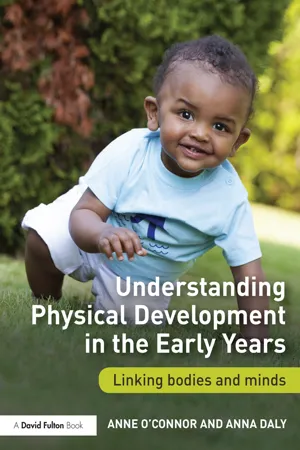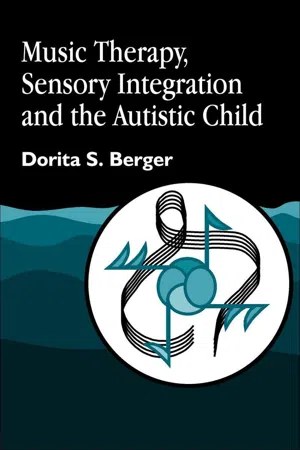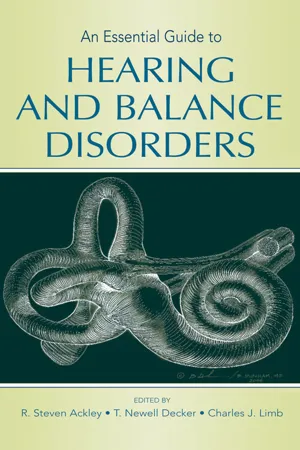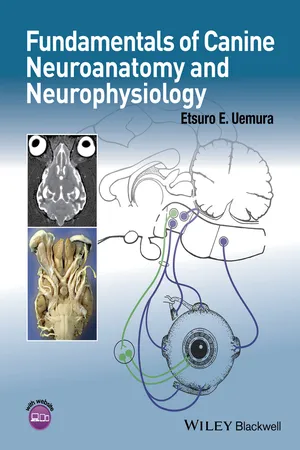Psychology
Vestibular Sense
The vestibular sense is the body's ability to sense and maintain balance and spatial orientation. It is primarily located in the inner ear and provides information about head position, movement, and acceleration. This sense helps individuals to navigate their environment and maintain stability during various activities.
Written by Perlego with AI-assistance
Related key terms
8 Key excerpts on "Vestibular Sense"
- eBook - ePub
Understanding Physical Development in the Early Years
Linking bodies and minds
- Anne O'Connor, Anna Daly(Authors)
- 2016(Publication Date)
- Routledge(Publisher)
Our Vestibular Sense is very important for helping us know and understand our physical position in space. We need to know the answers to questions such as ‘Is it me moving?’ and ‘Am I upside down?’ and to know when we are still but what we are looking at is moving or upside down. And when we are moving, we need our vestibular system to work in conjunction with the muscles in our eyes, our necks and heads to keep our vision stable so that we can see where we are going and feel a sense of gravitational security. This is why our Vestibular Sense is so important in guiding us through the process of becoming a ‘terranaut’ (Barsch 1968) and learning to manage the effects of gravity. Unless we are astronauts, the likelihood is that we will experience gravity throughout our lives and, as we take it for granted, we actually don’t notice it.How does the vestibular system work?
First of all, let’s identify the different parts of the vestibular system. It’s composed of vestibular receptors in the inner ear and linked to the mid-region of the brain. Because our world is three-dimensional, there are three semicircular canals inside the inner ear. They each contain tiny hairs with nerve endings (cilia), which move about in the fluid surrounding them, in response to the body’s movements. The movement of the fluid stimulates the nerve endings, and they send messages to the brain with regard to exactly what the body needs to do to find its balance. If you spin yourself round and round (and you don’t have the ‘spotting skill’ that enables dancers and others to reduce the effects), you will feel dizzy when you stop, because the fluid in the ears will probably continue moving for a short while afterwards. When the fluid stops moving, you will regain your balance and stop feeling dizzy (Connell and McCarthy 2014:85).Movement is the key
Our vestibular system is crucial to our sense of ourselves in space and in relation to everything around us and movement is the key to enabling the vestibular system to develop well enough to make sense of it all.That’s because movement constantly challenges the brain to adjust and record its understanding of what it feels like to be ‘in’ and ‘out’ of balance. And only when the brain has that understanding can it adapt to changing circumstances and help keep us from falling over. - Dorita S. Berger(Author)
- 2002(Publication Date)
- Jessica Kingsley Publishers(Publisher)
Both vestibular and proprioceptive systems are interoceptive (internal monitoring) processes receiving and transmitting to the brain sensory information derived in a variety of ways. The third system interacting with the two above is the tactile system, which processes touch sensations from external sources (skin) and internal sources (including the tongue). The senses of taste and smell are tactile-system relatives; smell receptors are connected directly to areas of the amygdala and hypothalamus. Visual and auditory systems come into play at higher levels of brain processing. Using the vestibular, proprioceptive and tactile systems, the whole brain amalgamates incoming and outgoing information to define the world. The cooperative, simultaneous workings of the five basic systems coalesce to provide the myriad of functions typical to human behaviors. The vestibular system Gravity is the human being’s first problem! As soon as the infant floats out of the womb it is confronted by gravitational pressures. The DNA information (inscriptive adaptation) is in place to inform the brain how to cope with the sensation of falling, and how to sustain itself against gravitational forces. You will notice a newborn immediately stiffen and thrust both arms into space as a corrective reaction to the sensation of being pulled downward. This is the work of the vestibular system. The vestibular system is a highly complex operation that interprets body position and spatial orientation based on the position of the head.For instance, how does the brain know that the tower of Pisa is leaning, and not you? Because, among other things, the brain knows the exact position of your head based on sensations flowing from vestibular receptors within the ears: hair cells (cristae) located in the semicircular canals (there are three), the utricle and the saccule of the vestibular labyrinth (Fisher 1991)- R. Steven Ackley, T. Newell Decker, Charles J. Limb(Authors)
- 2018(Publication Date)
- Psychology Press(Publisher)
CHAPTER 3The Vestibular System: Basic Principles and Clinical Disorders
Marc D. Eisen Charles J. LimbJohns Hopkins UniversityThe vestibular system acts to sense and control the head’s orientation in space with respect to linear and rotational motion. The purposes of the vestibular system are to maintain one’s orientation in space, postural stability, and gaze stability. Motion of the human body is typically a combination of turning, twisting, and leaning that can be complex to describe in three-dimensional space. Every complex motion in three-dimensional space, however, can be depicted as the vector sum of much simpler two-dimensional motions in the three orthogonal planes. As we will discuss, the normally functioning vestibular system utilizes such a strategy of reducing complex motion of the head in space into three orthogonal planes. This task is accomplished with two sets of vestibular sensory organs, one set on each side of the head; the two sides cooperate in a harmony of push-pull responses like children on a seesaw. As a result, disorders that cause an acute unilateral hypo- or hyper-function undermine this cooperation and cause the sensation of motion despite its absence (i.e., vertigo). This chapter uses as its foundation the basic cellular and neural anatomy of the vestibular system in order to describe its normal physiology. A description of the common vestibular disorders and their diagnosis and treatment is then presented based on how this normal vestibular function is altered.ANATOMYThe Sensory Hair CellThe peripheral vestibular organ and the cochlea have a common evolutionary origin. Given their common ancestry, it should come as no surprise that they utilize the same basic mechanotransducer—the sensory hair cell (Fig. 3-1- eBook - ePub
- Maria A. Patestas, Leslie P. Gartner(Authors)
- 2016(Publication Date)
- Wiley-Blackwell(Publisher)
vestibular system. The vestibular system, a proprioceptive (somatosensory) system, mediates the special functions of muscle tone, posture maintenance, equilibrium, and coordination of head and eye movements. Also, it transmits sensory information to the brain regarding the position of the body and spatial orientation.The vestibular system is equipped with two groups of receptors. One group detects angular acceleration (rotational movement) of the head, as in turning the head from side to side. The other group of receptors detects spatial orientation of the head in space, relative to gravity and linear acceleration or deceleration forces.Sensory input from the visual, vestibular, and proprioceptive systems is integrated by the nervous system, especially the cerebellum, to generate motor responses that maintain equilibrium, posture, muscle tone, and reflex movements of the eyes, all of which are carried out at the subconscious level.Muscle spindles, Golgi tendon organs and free nerve endings relay conscious proprioceptive sensory information via the dorsal column-medial lemniscus pathway to the somatosensory cortex. These same types of receptors relay unconscious proprioceptive information from muscles, tendons and joint capsules via the ascending sensory pathways to the cerebellum, which informs the cerebellum of the current orientation of the body. Via these pathways, the sensory cortex and the cerebellum construct a map of the body's orientation and motion at all times. This information is used in the coordination of impending movement.The vestibular apparatus relays sensory information about the orientation and motion of the head to the vestibular nuclei and cerebellum. The vestibular nuclei project via the medial longitudinal fasciculus (MLF) to the oculomotor, trochlear, and abducens motor nuclei that innervate the extraocular muscles to coordinate eye movements in response to head movements. The vestibular nuclei also project via the MLF to thalamic nuclei, which, in turn project to the vestibular sensory cortex for conscious - eBook - ePub
Attention, Balance and Coordination
The A.B.C. of Learning Success
- Sally Goddard Blythe(Author)
- 2011(Publication Date)
- Wiley(Publisher)
Affective symptoms of depression and anxiety can also develop: the former as a result of feeling generally unwell and out of touch with the world; the latter because the emotional sense of security is partly based on physical stability. If vestibular dysfunction is extreme, it can lead to loss of self-reliance, self-confidence, and self-esteem. It is therefore hardly surprising that a child with undiagnosed vestibular dysfunction may struggle to achieve in the classroom and may also develop problems of a behavioural nature.To summarize, the vestibular system is involved in the filtering and fine-tuning of all sensory information before it enters the brain – light, sound, motion, gravitational energy, air pressure, and temperature. It is responsible for controlling and for fine-tuning our vision; hearing; balance; sense of motion, altitude, and depth; sense of smell; sense of time; sense of direction; and anxiety/depression levels as mentioned above. Therefore, any one or a cluster of these processes can be affected when suffering from an inner ear dysfunction. Specific learning difficulties and perceptual problems are only a few of the possible symptoms that can arise from a dysfunction of the inner ear. Because the functioning of the vestibular system is so closely linked via the reticular activating system to the functioning of the autonomic nervous system, inner ear dysfunction can also have a significant impact on emotions and on behaviour at any time through the lifespan.REFERENCES1 Hippocrates. In: Hippocrates VII . 1994. Epidemics 2/4–7. The Nature of Man . Trans. Wesley D Smith. Loeb Classical Library, Harvard University Press, Cambridge, MA.2 Golding J. 2007. Motion sickness: friend or foe? The Inaugural Lecture of John Golding . March 2007, London.3 Cox JM. 1804. Practical Observations in Insanity , pp. 106. Baldwin and Murray, London.4 Hallaran WS. 1810.An Enquiry into the Causes Producing the Extraordinary Addition to the Number of Insane, Together with Extended Observations on the Care of Insanity: with Hints as to the Better Management of Public Asylums. Edwards & Savage, Cork.5 Purkinje J. 1820. Beiträge zur näheren Kenntniss des Schwindels aus heautognostischen Daten. Medicinische Jahrbücher des Kaiserlich-königlichen Österreichischen Staates - Etsuro E. Uemura(Author)
- 2015(Publication Date)
- Wiley-Blackwell(Publisher)
18 Vestibular SystemThe vestibular system maintains stable eye and body position in response to changes in head position. This system does so by sensing head motion and regulating lower motor neurons innervating the body and the extraocular eye muscles. Body position is maintained by activating the descending vestibular influence on extensor muscles. When the body starts falling to one side, the extensor muscles on the falling side will contract more strongly. This adjustment is mediated by the descending tracts of the vestibular nuclei that excite lower motor neurons for extensor muscles. When the head turns to one side, the vestibular system drives the eyes to the opposite direction, so that a stable retinal image can be maintained. A lesion affecting the vestibular system interferes with this reflex response of the eyes, triggering abnormal eye movement. Thus, any lesion that affects the vestibular system causes the body to lose its orientation and may result in head tilt, circling, and falling toward the side of the lesion.Organization of the vestibular system
- What is the vestibular organ? Where is it located?
- What are the names of the canals and chamber of the osseous labyrinth?
- What are the names of the three ducts and two chambers of the membranous labyrinth? How do they fit into the osseous labyrinth?
- What fluids fill the osseous and membranous labyrinths?
The vestibular system consists of the vestibular organ in the inner ear, vestibular nerve, vestibular nuclei in the medulla oblongata, and three tracts (medial longitudinal fasciculus, medial and lateral vestibulospinal tracts) that originate from the vestibular nuclei. The vestibular organ contains sensory receptors sensitive to head movement. The vestibular nerve mediates sensory signals from the receptors in the vestibular organ to the vestibular nuclei and the flocculonodular lobe of the cerebellum. The vestibular nuclei and the flocculonodular lobe also exchange fibers as they work together to maintain gaze and body equilibrium. The vestibular nuclei give rise to three tracts that control eye and body positioning in response to changes in head position. Vestibular control of eye position is mediated by the medial longitudinal fasciculus. This tract ascends to innervate the motor nuclei of the oculomotor, trochlear, and abducent nerves. Vestibular control of body position is carried out by the two descending tracts, the lateral and medial vestibulospinal, that facilitate lower motor neurons innervating extensor muscles.- eBook - ePub
- Alain Berthoz, Giselle Weiss(Authors)
- 2002(Publication Date)
- Harvard University Press(Publisher)
The brain has to reinterpret the information transmitted by these receptors to be able to compare them with sensations from other proprioceptive and visual receptors. Finally, let me reiterate a point that is often poorly understood: vestibular receptors are not only sensors of movement. They also signal immobility. Indeed, these sensors have a basic discharge whose lack of variation is interpreted by the brain as immobility. They are essential for assessing what is called the subjective vertical (see Chapter 4). Although they make it possible to recognize head movements, vestibular receptors alone are not enough, because of the ambiguous information they provide. For example, they cannot distinguish between acceleration of the head in one direction and braking in the other direction. Tactile or visual information helps to resolve this ambiguity. This clearly shows how perception requires cooperation among the senses. Another ambiguity that has already been mentioned is the distinction between the angle of tilt of the head and linear acceleration. This is known as the problem of gravito-inertial differentiation, and I will refer to it again in Chapter 13. To this problem nature found a solution, called frequential filtering. It consists in separating the two components of movement at the level of the first sensory relays, in the so-called vestibular nuclei and perhaps even at the level of the fibers that connect the receptors to these first relays. In fact, in the vestibular nuclei there are two kinds of neurons. Some respond especially to slow variations in acceleration, but are indifferent to rapid movements. The solution is an elegant one, because detecting the angle of tilt of the head involves slow neurons, and detecting acceleration involves rapid neurons. Others are highly activated by very rapid movements of the head and only slightly by slow movements - eBook - ePub
- James R. Augustine(Author)
- 2016(Publication Date)
- Wiley-Blackwell(Publisher)
Stimulation in the depth of the intraparietal sulcus in a patient with a brain tumor (meningioma) resulted in a detailed account of the perception of rolling in one direction. Electrical stimulation in the vestibular cortex of the parietal lobe in humans may evoke a sense of rotating or body displacement while the world around the patient remains stationary; seizure discharge here often yields an epileptic aura of that type. In another patient, stimulation of the parieto‐occipital junction on the lateral surface of the cerebral hemisphere caused vertigo. Everything appeared to be moving in a clockwise direction. These sensations resembled those that accompanied her previous seizures. In another patient, a right parieto‐occipital tumor initially irritated the parietal vestibular cortex (area 2v), causing a sensation of spinning. At times, the patient saw himself upside down. As the tumor continued to grow, there was disorientation in space and inversion of body image. Vertigo, the abnormal perception of movement or orientation, is likely to be secondary to injury to (pathological dysfunction) or stimulation of the parietal vestibular cortex.There is integration of vestibular input with other sensory modalities (proprioceptive and visual) at cortical levels. Therefore, it is reasonable to conclude that spatial skills functionally related to the parietal lobe such as right–left discrimination, directional sense, and body image, among others, are to some extent dependent on vestibular input and vestibulo–visual–somatosensory integration, a characteristic feature of the vestibular cortical processing.Temporal vestibular cortex
Vestibular sensations occur during temporal lobe stimulation in patients undergoing exploratory craniotomy for focal epilepsy. The temporal vestibular cortex (Fig. 11.7 ) in humans is on the superior temporal convolution along the rostral part of the temporal operculum. An expanding intracranial tumor that stimulated a vestibular area on the medial aspect of the temporal operculum and the insula led to dizziness in a patient. As the tumor grew and destroyed this region, these vestibular symptoms disappeared. Irritative injury to this temporal lobe region led to the subjective feeling of whirling or the patient is likely to rotate in a quiet environment or feel as though they are rotating. Whether of parietal or temporal lobe origin, vestibular sensation is a complex phenomenon requiring the correlation, integration, and association of many types of sensations from various cortical areas. Rich interplay and complex association of vestibular‐related information probably take place in that area of the temporal lobe adjacent to the temporal vestibular cortex. This area likely functions as a vestibular association area (Fig. 11.7
Learn about this page
Index pages curate the most relevant extracts from our library of academic textbooks. They’ve been created using an in-house natural language model (NLM), each adding context and meaning to key research topics.







